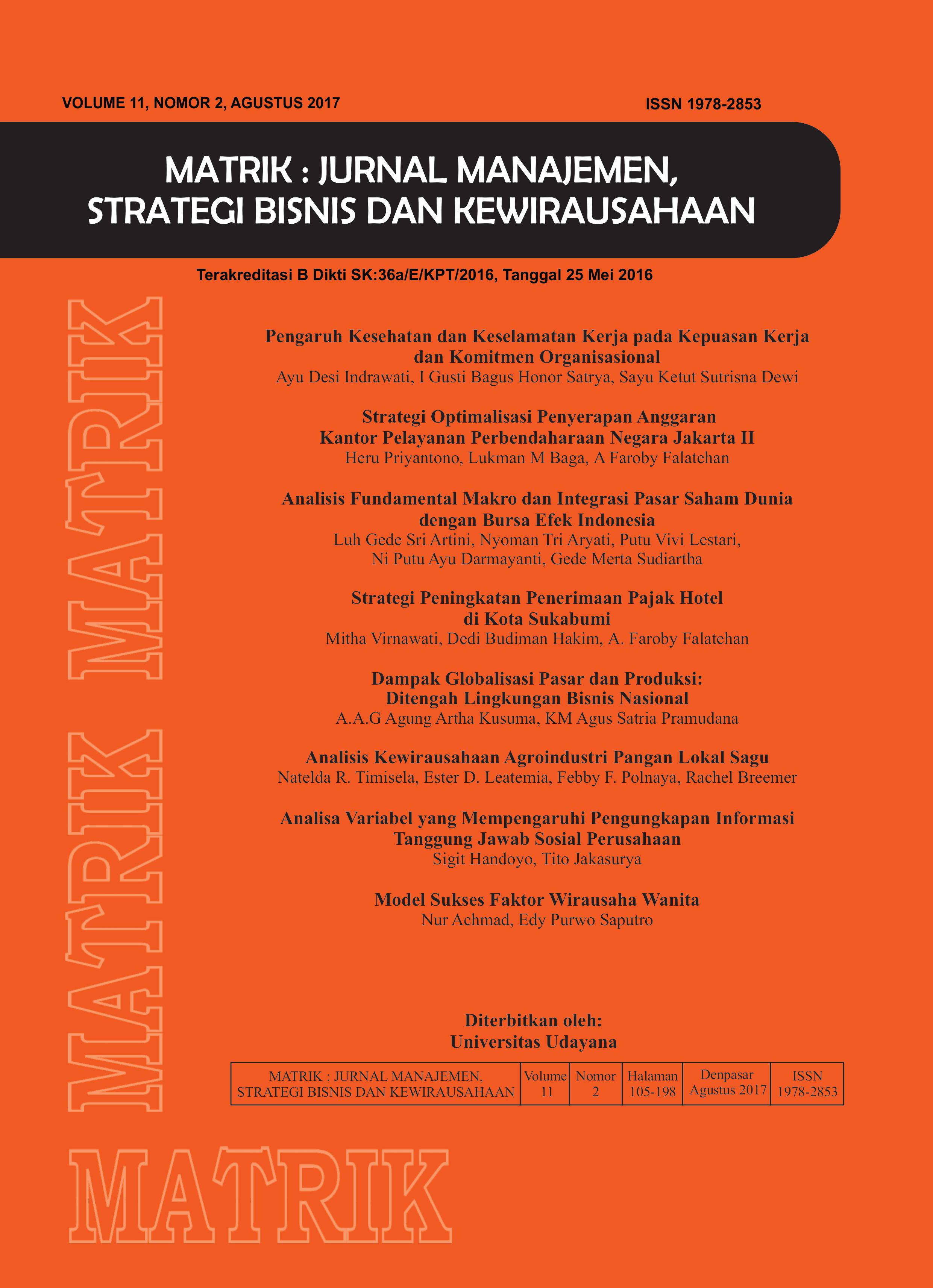MODEL SUKSES FAKTOR WIRAUSAHA WANITA
Abstract
Women entrepreneurs, an important factor supporting the economy and the research, present a variety of success factors that interesting to observe. This study aims to explore these three success factors of entrepreneurship including; bank credit, training, motivational, and inspirational success through the survey stage. This analysis shows that the three success factors effect on the amount of assets, production levels, productivity, and total profit, despite the success factor has no effect on increasing the number of workers. Limitation of this study is the homogeneity of the respondents, then this probably to become a reference for the further research as well as a research gap.
Downloads
References
Achmad, N. dan Saputro, E.P. (2015). Model sukses faktor wirausaha wanita. Laporan Penelitian Hibah Bersaing Tahun Pertama. Dikti.
Achmad, N. (2012). Model Edukasi Pengembangan Sikap Motivasi Wirausaha. Laporan Penelitian Kolaboratif. FEB UMS.
------- (2013). Pengaruh Mentoring Terhadap Sikap dan Niat Wirausaha. Laporan Penelitian Kolaboratif. FEB UMS.
Alam, S.S., Senik, Z.C., dan Jani, M.F.M. (2012). An exploratory study of women entrepreneurs in Malaysia: Motivation and problems. Journal of Management Research. 4 (4): 282-297.
----- Jani, M.F.M., dan Omar, N.A. (2011). An empirical study of success factors of women entrepreneurs in southern region in Malaysia. International Journal of Economics and Finance. 3 (2): 166-175.
Al-Dajani, H. dan Marlow, S. (2013). Empowerment and entrepreneurship: A theoretical framework. International Journal of Entrepreneurial Behaviour & Research. 19 (5): 503-524.
Aramand, M. (2013). Women entrepreneurship in Mongolia: The role of culture on entrepreneurial motivation. Equality, Diversity and Inclusion: An International Journal. 32 (1): 68-82.
Blackburn, R. dan Kovalainen, A. (2009). Researching small firms and entrepreneurship: Past, present and future. International Journal of Management Reviews. 11 (2): 127-148.
Canizares, S.M.C. dan Garcıa, F.J.F. (2010). Gender differences in entrepreneurial attitudes. Equality, Diversity and Inclusion: An International Journal. 29 (8): 766-786.
Chong, W.Y. (2012). Critical success factors for small and medium enterprises: Perceptions of entrepreneurs in urban Malaysia. Journal of Business and Policy Research. 7 (4): 204-215.
Dawson, C. dan Henley, A. (2012). “Push” versus “pull” entrepreneurship: An ambiguous distinction? International Journal of Entrepreneurial Behaviour & Research. 18 (6): 697-719.
Durán-Encalada, J.A., Martin-Reyna, J.M., dan Montiel-Campos, H. (2012). A research proposal to examine entrepreneurship in family business. Journal of Entrepreneurship, Management and Innovation, 8 (3): 58-77.
Forson, C. (2013). Contextualising migrant black business women’s work-life balance experiences. International Journal of Entrepreneurial Behaviour & Research. 19 (5): 460-477.
Gonzalez-Alvarez, N. dan Solis-Rodriguez, V. (2011). Discovery of entrepreneurial opportunities: A gender perspective. Industrial Management & Data Systems. 111 (5): 755-775.
Hair, J.F., Anderson, R.E., Tatham, R.L. dan Black, W.C. 1998. Multivariate Data Analysis 5th ed., New Jersey, Prentice Hall.
Hattab, H. (2012). Towards understanding female entrepreneurship in Middle Eastern and North African countries: A cross-country comparison of female entrepreneurship. Education, Business and Society: Contemporary Middle Eastern Issues. 5 (3): 171-186.
Hirschi, A. dan Fischer, S. (2013). Work values as predictors of entrepreneurial career intentions. Career Development International. 18 (3): 216-231.
Hoyos-Ruperto, M.D., Romaguera, J.M., Carlsson, B., dan Lyytinen, K. (2013). Networking: A critical success factor for entrepreneurship. American Journal of Management. 13(2): 55-72.
Ireland, R.D., Reutzel, C.R., dan Webb, J.W. (2005). Entrepreneurship research in AMJ: What has been published, and what might the future hold? Academy of Management Journal. 48 (4): 556-564.
Itani, H., Sidani, Y.M., dan Baalbaki, I. (2011). United Arab Emirates female entrepreneurs: Motivations and frustrations. Equality Diversity and Inclusion: An International Journal. 30 (5): 409-424.
Jamali, D. (2009). Constraints and opportunities facing women entrepreneurs in developing countries: A relational perspective. Gender in Management: An International Journal. 24 (4): 232-251.
Javadian, G. dan Singh, R.P. (2012). Examining successful Iranian women entrepreneurs: An exploratory study. Gender in Management: An International Journal. 27 (30): 148-164.
Kargwell, S.A. (2012). Women entrepreneurs breaking through: Push and pull within UAE cultural context. International Journal of Business and Social Science. 3 (17): 122-131.
Kumar, A. (2013). Women entrepreneurs in a masculine society: Inclusive strategy for sustainable outcomes. International Journal of Organizational Analysis. 21 (3): 373-384.
Kwong, C., Jones-Evans, D., dan Thompson, P. (2012). Differences in perceptions of access to finance between potential male and female entrepreneurs: Evidence from the UK. International Journal of Entrepreneurial Behaviour & Research. 18 (1): 75-97.
Kyrgidou, L.P. dan Petridou, E. (2013). Developing women entrepreneurs’ knowledge, skills and attitudes through e-mentoring support. Journal of Small Business and Enterprise Development. 20 (3): 548-566.
Lee, L. dan Yang, C.L. (2013). Key success factors in female micro entrepreneurship : A study of the catering business. Service Science and Management Research (SSMR). 2 (3): 39-47.
Marlow, S. dan McAdam, M. (2013). Gender and entrepreneurship: Advancing debate and challenging myths; exploring the mystery of the under-performing female entrepreneur. International Journal of Entrepreneurial Behaviour & Research. 19 (1): 114-124.
Murphy, G. B., Trailer, J. W., dan Hill, R. C. (1996). Measuring performance in entrepreneurship research. Journal of Business Research, 36 (1): 15-23.
Nawaz, F. (2009). Critical Factors of Women Entrepreneurship Development in Rural Bangladesh. Bangladesh Development Research Working Paper Series. Bangladesh Development Research Center (BDRC).
Pathak, S., Goltz, S., dan Buche, M.W. (2013). Influences of gendered institutions on women’s entry into entrepreneurship. International Journal of Entrepreneurial Behaviour & Research. 19 (5): 478-502.
Patterson, N., Mavin, S., dan Turner, J. (2012). Envisioning female entrepreneur: Leaders anew from a gender perspective. Gender in Management: An International Journal. 27 (6): 395-416.
Perwej, A. (2012). The women adoption in owned businesses and entrepreneurship in India. International Journal of Emerging Trends & Technology in Computer Science (IJETTCS). 1 (4): 56-61.
Pines, A.M., Lerner, M., dan Schwartz, D. (2010). Gender differences in entrepreneurship: Equality, diversity and inclusion in times of global crisis. Equality, Diversity and Inclusion: An International Journal. 29 (2): 186-198.
Rao, V., Venkatachalm, A., dan Joshi, H.G. (2013). A study on entrepreneurial characteristics and success of women entrepreneurs operating fashion and apparel business. Asian Journal of Management Sciences and Education. 2 (2): 136-147.
Raposo, M. dan do Paço, A. (2011). Entrepreneurship education: Relationship between education and entrepreneurial activity. Psicothema. 23 (3): 453-457.
Robichaud, Y., Cachon, J.C., dan Haq, R. (2010). Motives, success factors, and barriers among Canadian female entrepreneurs: The Case of Greater Sudbury. Entrepreneurial Practice Review. 1 (2): 36-65.
Sánchez, J.C dan Gutiérrez, A. (2011). Entrepreneurship research in Spain: Developments and distinctiveness. Psicothema. 23 (3): 458-463.
Short, J.C., Moss, T.W., dan Lumpkin, G.T. (2009). Research in social entrepreneurship: Past contributions and future opportunities. Strategic Rntrepreneurship Journal. 3: 161-194.
Simpeh, K.N. (2011). Entrepreneurship theories and empirical research: A summary review of the literature. European Journal of Business and Management. 3 (6): 1-8.
Siringi, E.M. (2011). Women’s small and medium enterprises for poverty alleviation in Sub-Saharan Africa: Lessons from Kenya. Management Research Review. 34 (2): 186-206.
Sullivan, D.M. dan Meek, W.R. (2012). Gender and entrepreneurship: A review and process model. Journal of Managerial Psychology. 27 (5): 428-458.
Vadnjal, J., dan Vadnjal, M. (2013). The role of husbands: Support or barrier to women’s entrepreneurial start-ups? African Journal of Business Management. 7(36): 3730-3738.
van Gelderen, M., Brand, M., van Praag, M., Bodewes, W., Poutsma, E., dan van Gils, A. (2008). Explaining entrepreneurial intentions by means of the Theory of Planned Behaviour. Career Development International. 13 (6): 538-559.
Veciana, J.M. dan Urbano, D. (2008). The institutional approach to entrepreneurship research: Introduction. International Entrepreneurship Management Journal. 4: 365-379.
Zhu. L. dan Chu, H.M. (2010). Motivations, success factors and problems encountered by Chinese women entrepreneurs: A factor analysis. International Review of Business Research Papers. 6 (5): 164-180.
Zulkifli, R.M. dan Rosli, Z.M. (2013). Entrepreneurial orientation and business success of Malay entrepreneurs: Religiosity as moderator. International Journal of Humanities and Social Science. 3 (10): 264-275.
Keywords
 This work is licensed under a Creative Commons Attribution-ShareAlike 4.0 International License.
This work is licensed under a Creative Commons Attribution-ShareAlike 4.0 International License.

















